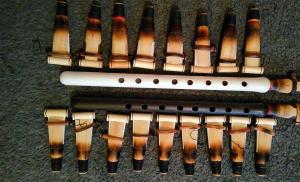How and which camera to choose. Compact devices of varying degrees of sophistication
The first thing to do before buying is to find information on the Internet about the model you have chosen: sometimes entire batches with the same marriage enter the market, and you need to know in advance about the likelihood of meeting with a similar one.
In the shop
Feel free to spend as much time checking the camera as you need. The seller's task is to sell you a product, even with a marriage, but your task is to buy a serviceable model. Take the camera in your hands and carefully inspect the case: are there any scratches, screws are not touched. Check the buttons, covers, whether the battery is securely seated.
Prepare in advance and bring your laptop with you installed program Exif-O-Matic. Take a test shot, open it in this program and look for the Exposure Sequence Number parameter: this is the number of frames captured. If their number is small, the camera may have been used in a store. But a large number most likely indicates that the camera was bought, used, and then returned to the store. Ask for another copy.
Check for dead and hot pixels. Set the following values: shutter speed 1/60 sec, ISO 100. Take a picture of a white sheet of paper, examine it on a laptop: if black dots are visible, these are dead pixels. Then remove the lens, close the camera cap and take another shot: the white dots are still the same dead pixels. Hot pixels can be detected as follows: alternately set the shutter speed to 1/3 sec and 2 sec (if there is a noise reduction function, it must be turned on at this shutter speed) with ISO 100. Pictures to search for damaged pixels should be viewed at 100% magnification. You can remove damaged pixels in the warranty service, but if their number is large, you should immediately ask for another copy.
The last thing you need to pay attention to is the work of the focus. As a rule, in stores you can find special tables for checking the focus, but you can use a regular ruler and a match. The line is placed on White list paper vertically, the match is perpendicular to it, in the middle. At an angle of 45 degrees, take a picture of a match and a ruler. Focus on the near or far end of the ruler - focus error. If the match is in focus, as intended, pay attention to the depth of field: it should be approximately the same above and below the match.
Purchase process
The camera is a complex and fragile technique, and the more reliable your seller is, the more likely it is to avoid a defective or used model, as well as to receive service services on time and without difficulty. In specialized stores, the price of goods is often overpriced, while in electronics hypermarkets, it is necessary to carefully check the camera for the absence of defects before buying. Be sure to check the documents and warranty card, appearance packaging.
Ordering from an online store will be a certain risk: if there is no alternative, do not spare money for good name seller and good courier delivery.
Publication date: 14.02.2017
How to choose a camera?
In all the abundance of photographic equipment on the market, it is very difficult to understand. Prices fluctuate widely, the feature set varies greatly. What camera to buy? The purpose of this article is to help you choose a camera based on your goals and budget.
Camera types
Smartphone camera
The main trend in the photography market is relentless: smartphones are improving and getting better at tasks that used to require a camera. A smartphone today is not only a means of communication and a camera, but also an audio, video player, navigator, game console and even bank card with a pass. And if you can forget the camera at home, then the smartphone and its camera are always with you. Another bonus: a picture taken on a smartphone can be immediately sent to friends or published on a social network.
Smartphones are available to almost everyone. If you do not take into account the top models from leading manufacturers, then the average price tag is very democratic. Thanks to the emergence of high-quality Chinese smartphones, anyone can become the owner of an advanced device. But the prices for photographic equipment soared after the dollar: these days a serious camera is an expensive pleasure.
However, cameras in smartphones still have a number of disadvantages:
Poor quality photos and videos. Smartphones have small image sensors, and their size affects image quality. Such sensors create more digital noise, which is especially critical when shooting in low light conditions. The appearance in some phones of shooting in RAW and manual settings is a pleasant innovation, but it did not make the weather.
 EVA-L19 SETTINGS: ISO 320, F2.2, 2s, 27.0mm equiv.
EVA-L19 SETTINGS: ISO 320, F2.2, 2s, 27.0mm equiv.
No optical zoom (except for a few specific models). A smartphone cannot capture a distant object in high quality.
Absence interchangeable optics, which would solve the problem of lack of zoom. Modern "lenses for smartphones" are attachments for the optics already available in the phone and cannot be compared with high-quality interchangeable photo optics.
Let's summarize. The smartphone camera is suitable for solving household photo tasks, capturing the moment. However, for more or less advanced work with photos and videos, it is better to choose a camera. Even to maintain an Instagram account, bloggers more often use not smartphones, but more specialized equipment: from action cameras to full-frame cameras. SLR cameras. More advanced tools are also used for professional photo and video shooting.
A smartphone should be considered as a camera if ...
- you do not plan to master photographic equipment and manual settings, but just want to take nice shots and selfies;
- you are a beginner blogger and are looking for budget equipment;
- you need a universal gadget for all tasks: from networking to shooting simple videos;
- you are a photographer who is tired of carrying around a heavy camera (yes, a smartphone is perfect for many areas of creative photography).
Here are the three most relevant devices today:
Samsung Galaxy S7 edge

It has one of the best cameras on the mobile market, capable of delivering impressive results even at night. With S7 edge you can take a great underwater selfie! And the presence of a manual mode and the ability to shoot in RAW will be useful for advanced amateurs. You can save a little and buy a regular S7. It has a smaller display diagonal and, as a result, slightly smaller sizes and battery size. The screen is not curved, but the camera is like in S7 edge.
Huawei P9 and P9 Plus

The camera of this gadget was made in collaboration with professionals from Leica. This is the most affordable Leica camera on the market. Here is a handy photo app with large quantity modes, manual settings and shooting in RAW. One of the main features is a dual camera with two sensors: RGB and monochrome, each with a resolution of 12 megapixels. You can take both color and black and white pictures.
iPhone 7 Plus

The iPhone is one of the most powerful mobile photography engines. Over the 10 years of the existence of a smartphone, this direction has made great progress: confirmation of this is advertising campaign"Shot on an iPhone." The iPhone 7 Plus with 28 and 56 mm lenses (equiv.) has one of the best mobile cameras of our time, the capabilities of which are expanded by third-party applications (up to manual settings and shooting in RAW).
compact cameras


Super zooms may be of interest to those who care about a high zoom ratio, simple solutions"all in one" and affordable price. Any system (SLR or mirrorless) camera with a telephoto lens will give noticeably top scores both in terms of image quality and speed, but it will cost a little more and require the purchase of additional optics.
 Canon PowerShot SX540 HS / (65535) SETTINGS: ISO 1600, F4.5, 1/40s
Canon PowerShot SX540 HS / (65535) SETTINGS: ISO 1600, F4.5, 1/40s
advanced compact cameras
To survive under the onslaught of smartphones, compact cameras had to evolve not only in the direction of increasing the zoom, but also in the direction of improving the image quality. Today's class of advanced compacts is not one-button "soap dishes", but serious cameras enclosed in a compact body and capable of competing with DSLRs and mirrorless cameras.
They are equipped with large sensors (from one-inch to full-frame), high-aperture fixes or optics with a moderate zoom. These cameras are fast and easy to use, allow you to adjust all shooting parameters. Many advanced compacts are good at recording video: you can shoot in 4K resolution with them, use professional video recording features.
Almost all modern advanced compacts have a convenient folding display. In some models, it can be rotated towards the lens, which makes such cameras a good solution for taking selfies and recording vlogs. Another advantage is the thoughtful design.

Reference representatives of this class: the Sony RX-100 line, in which a novelty has recently appeared (DSC-RX100M5), Canon PowerShot G7 X Mark II, Canon PowerShot G9 X, Panasonic Lumix DMC-LX10 and others.
 DSC-RX100M4 SETTINGS: ISO 125, F7.1, 30s, 24.0mm equiv.
DSC-RX100M4 SETTINGS: ISO 125, F7.1, 30s, 24.0mm equiv.
These cameras are convenient for travelling, they perfectly cope with the role of the second camera of a professional. If you are a beginner, but you have enough money for a camera from this segment, do not be stingy: the quality of photos and videos will not disappoint you.
 DSC-RX100M4 SETTINGS: ISO 2000, F3.5, 1/80s, 70.0mm equiv.
DSC-RX100M4 SETTINGS: ISO 2000, F3.5, 1/80s, 70.0mm equiv.
Advanced compact cameras with large zoom
Should be highlighted in separate class advanced compact cameras equipped with large 1″ sensors and powerful zoom. The so-called bridge-cameras have inherited many features of superzooms, but have a number of features. They have a more developed control that allows you to quickly change settings and shoot in manual mode, a lens with a large zoom ratio. Range focal lengths not as big as superzooms (usually from 8x to 20x), but there are also champions with 30x or 40x zoom. Model examples: , Canon PowerShot G3 X .

 DSC-RX10M3 SETTINGS: ISO 125, F5.6, 1/250s, 380.0mm equiv.
DSC-RX10M3 SETTINGS: ISO 125, F5.6, 1/250s, 380.0mm equiv.
This class of cameras will be of interest to those who want to move from a simple superzoom to something more advanced, but so far either cannot afford a system camera or do not want to mess with bulky interchangeable lenses.
 Canon PowerShot G3 X / (65535) SETTINGS: ISO 4000, F5.6, 1/125 s
Canon PowerShot G3 X / (65535) SETTINGS: ISO 4000, F5.6, 1/125 s
With such cameras it is comfortable to travel, shoot family and household plots. The picture quality is much higher than that of superzooms. But keep in mind that they can be comparable in size to system (reflex or mirrorless) cameras and are somewhat inferior to them in image quality due to the smaller size of the matrix.
SLR Cameras
A DSLR is an excellent solution for an amateur photographer who plans to improve his skills, learn, use all creative and technical shooting techniques. SLR cameras are equipped with large sensors (full-frame or APS-C), thanks to which you can get very high quality Images. They are very flexible in operation and are suitable for all types of shooting. You just need to choose the right lens.
Why is a SLR camera called that? Its design is based on a movable mirror, which is necessary for viewing the frame through the optical viewfinder.
SLRs designed for beginners can be purchased with a lens in the kit. Such trade offers are marked kit. The "whale" lens is ideal for beginner photographers. Professionals choose optics for their tasks, ordering a camera without a lens in the body package.
 X-T2 / XF10-24mmF4 R OIS SETTINGS: ISO 200, F11, 1/8s, 15.0mm equiv.
X-T2 / XF10-24mmF4 R OIS SETTINGS: ISO 200, F11, 1/8s, 15.0mm equiv.
SLR cameras entry level are relatively inexpensive. They are able to last longer on a single battery charge than compacts and mirrorless cameras. This is very important when traveling and on responsible shoots.
 PENTAX K-1 / HD PENTAX-D FA 24-70mm F2.8ED SDM WR SETTINGS: ISO 100, F8, 20s, 24.0mm equiv.
PENTAX K-1 / HD PENTAX-D FA 24-70mm F2.8ED SDM WR SETTINGS: ISO 100, F8, 20s, 24.0mm equiv.
All modern models have rich video capabilities. If entry-level devices become just a good family camcorder, then some advanced models are quite suitable for professional video work.
 ILCA-99M2 / 135mm F1.8 ZA SETTINGS: ISO 1600, F2.8, 1/100s, 135.0mm equiv.
ILCA-99M2 / 135mm F1.8 ZA SETTINGS: ISO 1600, F2.8, 1/100s, 135.0mm equiv.
However, cameras in this class are large. This is due to their design with a mirror inside, interchangeable lenses and a large matrix. The size of the SLR camera will depend on the size of the optics installed on it.
 Canon EOS 5D Mark IV / Canon EF 24-70mm f/2.8L II USM SETTINGS: ISO 100, F4, 1/60s
Canon EOS 5D Mark IV / Canon EF 24-70mm f/2.8L II USM SETTINGS: ISO 100, F4, 1/60s
A reflex camera is a whole system of devices and accessories. The purchase of a camera may be followed by expenses for lenses, flashes and other accessories that will be necessary if you are serious about photography.
Despite the fact that the market for SLR cameras is occupied by Japanese manufacturers for 74% of cameras, the competition is high. Into the battle of the titans Canon from 48% of the market and Nikon- from 29%) such giants interfere as Sony, Olimpus and Pentax. European companies Victor Hasselblad AB(Sweden) and Leica Camera AG(Germany) are focused on the professional sector of expensive medium format cameras. The famous German "Zeiss" optics are now in cameras Sony, and the creator of the mass passion for photographic art, American Kodak, practically abandoned the production of finished cameras, refocusing on components for them.
As a result of competition between manufacturers and the development of technology, the range of digital cameras and their electronic "stuffing" is rapidly changing. No sooner had photographers got used to the use of light-sensitive CCD-type matrices than they were almost supplanted by more economical CMOS matrices. The dimensions of the matrices also change. The size of 36x24 mm (full-frame, FF in English and Russian photo slang, respectively) has not only become the norm for the professional segment, but is clearly ready to appear in the semi-professional as well.
Using RAW was the privilege of the pros, and now this format is supported by entry-level cameras, including even digital cameras. The trend of “flowing” of many functions from the professional segment to the amateur segment pretty much confuses the classification of cameras by user groups. But when creating the TOP-10 SLR cameras, one cannot do without their classification.
Let's agree on terms
We will consider only popular mass cameras with a matrix size of no more than 36x24 mm and a price no higher than a mass Russian car, i.e. no more than 260,000 rubles. for the Body package (without lens). In general, in the professional and semi-professional segments, it is easier to compare digital cameras separately from lenses for two reasons.
- Firstly, the result of shooting is very dependent on the lens, and the choice of lens depends on the subjects.
- Secondly, optics practically reached the limits of its perfection already in the era of film cameras.
professional Let's call cameras that allow you to get frames at high speed and quality worthy of glossy magazines and large-format printing. Universal and reportage professional cameras must also be high-performance and suitable for work in different conditions sufficiently protected from moisture and dust, durable.
If the camera has a crop factor (the ratio of the frame diagonal of 36x24 mm to the diagonal of the so-called "cropped" matrix) within 1.3 - 1.6, then the camera can be called semi-professional or advanced amateur. Of course, if its other parameters are on high level.
SLR camera for beginners- this is a device with simple controls, low price and an inexpensive standard lens, allowing a beginner to master the basics of photography and decide on the direction of further development.
Every season, a whole bunch of new camera models of various price categories appear on the world market, with individual characteristics. To choose a camera which will be most convenient for you in all respects, I have divided all digital cameras into 5 categories. This will bring clarity to the sheer number of cameras you choose from online stores. Agree, it is simply impossible to compare models and understand their numerous characteristics directly when buying. The classification I propose choose the best camera or at least make an informed decision before buying a camera based on objective data.
Before you start analyzing the characteristics and types of cameras, decide on the following questions:
- For what purposes will the camera be used: amateur or professional?
- How much are you willing to spend on a device?
For example, professional shooting in addition to careful camera selection involves the purchase of various modules and additional accessories for the camera. System and SLR cameras require modernization through the purchase of interchangeable lenses, flashes and other components. Of course, most cameras from other categories can also be improved with additional accessories, but to a much lesser extent.
If you intend to use future pictures mainly for publishing on the Internet, but the quality provided by a smartphone, even with a good camera, is not enough, then make sure that the model has a built-in wi-fi (WLAN module). I advise you to take a closer look at cameras with Android OS on board, they will make posting photos on the Web even easier. The article will consider only those devices that have the functionality of video recording with Full HD support.
Mega smart cameras
Mega-smart cameras are a mixture between "DSLRs" and compact models. Their main feature is the widest range of focal lengths. These cameras are always equipped with large lenses and offer many manual settings. In such models, compact matrices are installed, but "megazooms" have dimensions that exceed the dimensions of conventional cameras.
Cameras in a protective housing
Users who prefer leisure and extreme sports place special demands on digital cameras. These devices must be compact, lightweight, shockproof, dust and moisture resistant, and manageable in any situation. When choosing this type of camera, you should pay close attention to the degree of security.
Universal cameras
Users who lack the capabilities of budget camera solutions and are not happy with the dimensions of megazoom or SLR cameras should take a closer look at universal models. They have an abundance of various settings, high-capacity batteries and the ability to install additional accessories and extensions. BUT big size matrix, in turn, allows you to create excellent pictures.
System cameras
In a nutshell, system camera is a "reflex camera", enclosed in a lightweight and compact body. This is one of the most promising types of cameras today.
SLR cameras
SLR camera provides the photographer great opportunities due to the presence of an interchangeable lens and a huge number of manual settings. To get acquainted with the “reflex camera”, the optics supplied with it (Kit - set) is quite suitable. But in some cases, buying a model without a lens will save you enough money to buy better-spec optics from a third-party manufacturer, depending on the camera mount.
Mega smart cameras
The main feature of megazoom cameras is a lens with a huge range of focal lengths, which makes it possible to shoot both with wide angle view and low magnification, and with a very narrow angle and a fairly large approximation. the main task manufacturer - to fit a fast universal lens in a compact body. As a result, one has to sacrifice either the neat dimensions of the lens in favor of aperture ratio and optical quality, or vice versa. In addition, the larger the telescopic lens, the more compact it is, but the less reliable and durable. Of course, megazoom cameras are larger than the average size of conventional compact models. We also note that such devices are primarily aimed at enthusiastic users, especially those who like to shoot panoramic photos or sports events.
Best Camera: Sony Cyber-shot DSC-HX20V
The best in terms of characteristics was the model from Sony. The camera attracts with its rich functionality, but at the same time, the 18-megapixel CMOS sensor has a not very large physical size - 1 / 2.3 ′(6.17 × 4.55 mm). The device is equipped with a three-inch screen and uses a micro-USB connector for both communication with a PC and for charging. The camera also has a built-in GPS module that allows you to tie photos to geographic coordinates and register a track, even when the device is turned off.
Best Choice: Canon PowerShot SX240 HS
This camera, with a very attractive price, has almost perfectly balanced characteristics: the points obtained in the main disciplines are almost equal. The camera offers an interesting (especially for fans of sports events) video shooting mode at a speed of 240 frames / s. The disadvantage of the model is, perhaps, the low resolution of the three-inch display (461,000 pixels) - the other representatives of this category have twice as much.
Protected cameras
These cameras are designed primarily for lovers of active and extreme types of recreation. In order to be able to use the devices under water, their cases are made completely sealed. The control buttons that standard models are the main conductors of water inside the case, in protected chambers they do not let it through, and the covers of the compartments for batteries and memory cards are equipped with special sealing gaskets. In addition, protected cameras are not afraid of shocks, sudden changes in temperature and pressure. However, it should be borne in mind that the degree of security of cameras is different, therefore, when purchasing such a model, you should carefully read the specification. You have to pay for protection both in the literal sense (such a camera, of course, is more expensive than a similar unprotected one), and in a portable one - these devices are larger and heavier than classic compact models and are not equipped with swivel displays.
Best Camera: Panasonic Lumix DMC-FT5
This model of a protected camera allows you to shoot photos and videos at a depth of up to 13 m. Also, Panasonic Lumix DMC-FT5 can withstand a fall from a 2-meter height. At the same time, the camera shows best quality images in the classroom and is well equipped: there are built-in WLAN and GPS modules, an NFC interface, as well as a hiking kit for a tourist: a compass, a barometer and an altimeter.
Best Choice: Sony Cyber-shot DSC-TX20
This is a member of the TX series (ultra compact rugged cameras from Sony) with a 3.3-inch touch screen features a stylish design, low price, rich features and excellent performance. This allowed the model to earn the title of the best choice in its class. The camera is water-resistant to a depth of 5 m, and shockproof is guaranteed when dropped from a height of no more than 1.5 m.
Universal cameras
Cameras in this class are still the best selling because they are the best choice among all categories of cameras. They have an impressive number of different settings, both manual and automatic, batteries of sufficient capacity and the possibility of purchasing additional accessories, such as a separate flash, as well as tele- and macro lens attachments. The large physical size of the matrix allows you to take very good shots, and in terms of image quality, under good lighting conditions, such cameras are comparable to SLR models. Universal cameras are well suited for all kinds of trips and travels, as well as situational shooting on the principle of "saw, got it, shot it." In favor of these devices is the fact that even many professionals purchase such devices as a second device for everyday use.
Best Camera: Canon PowerShot G1 X
The best camera in terms of image quality among those considered, this is facilitated by a matrix that is huge for this type of camera, exceeding the 4/3 standard used in system cameras. The device offers a ton of manual and automatic settings, a tilt-and-turn display, and plenty of mechanical controls. The only drawback is the low speed - this applies to continuous shooting, and to the shutter lag.
Best choice: Nikon Coolpix P7700
Yes, the camera is no longer a novelty, but it is still competitive. And here's why: high image quality, excellent equipment, a lot of manual settings (there are three dials for setting parameters, as many choices of operating modes and functions). Add to this the presence of a folding display, a fast lens and the largest optical zoom among those mentioned in the article. Yes, and a great price.
System cameras
Manufacturers have long been looking for a solution to overcome the limitations imposed by the presence of a mirror as a key element of SLR cameras. A few years ago, digital devices appeared on the mass market without mirrors, but with interchangeable optics. They began to be called system cameras, or “mirrorless”. The presence of a large sensor and interchangeable lenses allows you to get pictures of almost the same quality as that of SLR models. At the same time, their dimensions, weight and price are less due to the absence of a mirror block. The picture from the lens goes directly to the matrix, from it to the display and / or electronic viewfinder. This design makes it easy to use the tilt-and-turn display in shooting mode and record video, which requires considerable technical tricks for SLR cameras: you need to raise and fix the mirror, and send the image from the lens to the matrix, essentially turning the device into mirrorless.
Best Camera: Sony NEX-6
The picture quality and performance of this model, when compared with competitors, are almost perfect. In addition, Sony NEX-6 is very richly equipped. For perfection, only a movable display is missing, which rotates in only one plane.
Best Choice: Sony NEX-F3
The Sony NEX-F3 model, according to the test results, demonstrates the same image quality and resolution, since it uses a similar sensor. The ISO range of the younger model is narrower, and the noise at equal ISOs is higher, which is a consequence of simplified electronics. Of course, equipment and performance are very different downwards. But the battery life has even increased.
SLR cameras
SLR digital cameras in recent times ceased to be the lot of only professionals and enthusiasts. In a short time, a lot of budget amateur "DSLRs" appeared. Such models provide the photographer with great opportunities both due to the presence of interchangeable lenses, external flashes, devices for macro photography, and thanks to an impressive number of different settings, manual and automatic. According to your device SLR cameras fundamentally different from all others: in them, the image passing through the lens is projected not directly onto the matrix, but onto a mirror unit, from where it is then perceived by the photographer's eye through the optical viewfinder. Therefore, these devices allow you to immediately see and evaluate the frame. Entry-level DSLRs are well-suited for photography enthusiasts, but most users may find them bulky and difficult to use.
Top Product: Sony Alpha SLT-A77
This camera is based on translucent mirror technology, in which the light flux from the lens is divided between the sensor and the viewfinder, which increases the reliability and speed of shooting, since the mirror remains stationary during the photographing process. On the other hand, this design somewhat reduces the amount of light reaching the matrix. However, with the light sensitivity of modern matrices, this is not very significant. In addition, this camera is the most equipped among competitors.
Best choice: Canon EOS 60D
Camera with the best value for money and at the same time a well-balanced combination of key parameters. The advantages include a display that rotates in two planes (one of the first movable displays from this manufacturer) with high resolution. The disadvantage is the low burst speed and a fairly narrow ISO range. In addition, the high color noise makes it practically useless starting from 3200 units.
We often look back at old pictures, remembering joyful events and memorable dates. The camera helps to capture the moments dear to the heart. When choosing a camera, it is easy to get confused, because there is an abundance of equipment on the shelves. To choose the right device, you need to consider many points. For novice amateur photographers, ease of mastering the camera and high-quality results are important, and more experienced users attracts the possibility of manual shooting modes. Everyone can choose the best solution for their goals and objectives, based on the budget. A wide selection is available in our online store various models cameras, as well as many accessories for them. In this article, we will talk about what you should pay attention to when choosing a camera.
Camera options
The starting point when choosing a camera can be considered the intended shooting conditions and the expected results that the new camera should provide.
Of course, it makes no sense to buy expensive reflex camera, if you just want to shoot standard stories for the history of your family: holidays, birthdays or the first steps of a child. In this case, you should pay attention to ultra-compact cameras.













